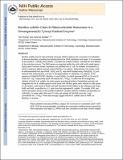| dc.contributor.author | Zhang, Yan | |
| dc.contributor.author | Stubbe, JoAnne | |
| dc.date.accessioned | 2012-08-14T21:30:07Z | |
| dc.date.available | 2012-08-14T21:30:07Z | |
| dc.date.issued | 2011-05 | |
| dc.date.submitted | 2011-03 | |
| dc.identifier.issn | 0006-2960 | |
| dc.identifier.issn | 1520-4995 | |
| dc.identifier.uri | http://hdl.handle.net/1721.1/72129 | |
| dc.description.abstract | Bacillus subtilis class Ib ribonucleotide reductase (RNR) catalyzes the conversion of nucleotides to deoxynucleotides, providing the building blocks for DNA replication and repair. It is composed of two proteins: α (NrdE) and β (NrdF). β contains the metallo-cofactor, essential for the initiation of the reduction process. The RNR genes are organized within the nrdI-nrdE-nrdF-ymaB operon. Each protein has been cloned, expressed, and purified from Escherichia coli. As isolated, recombinant NrdF (rNrdF) contained a diferric-tyrosyl radical [Fe(III)[subscript 2-]Y[superscript•] cofactor. Alternatively, this cluster could be self-assembled from apo-rNrdF, Fe(II), and O[subscript 2]. Apo-rNrdF loaded using 4 Mn(II)/β[subscript 2], O[subscript 2], and reduced NrdI (a flavodoxin) can form a dimanganese(III)-Y[superscript•] [Mn(III)[subscript 2-]Y[superscript•]] cofactor. In the presence of rNrdE, ATP, and CDP, Mn(III)[subscript 2-]Y[superscript•] and Fe(III)[subscript 2-]Y[superscript•] rNrdF generate dCDP at rates of 132 and 10 nmol min[superscript –1] mg[superscript –1], respectively (both normalized for 1 Y[superscript•]/β[subscript 2]). To determine the endogenous cofactor of NrdF in B. subtilis, the entire operon was placed behind a Pspank(hy) promoter and integrated into the B. subtilis genome at the amyE site. All four genes were induced in cells grown in Luria-Bertani medium, with levels of NrdE and NrdF elevated 35-fold relative to that of the wild-type strain. NrdE and NrdF were copurified in a 1:1 ratio from this engineered B. subtilis. The visible, EPR, and atomic absorption spectra of the purified NrdENrdF complex (eNrdF) exhibited characteristics of a Mn(III)[subscript 2-]Y[superscript•] center with 2 Mn/β[subscript 2] and 0.5 Y[superscript•]/β[subscript 2] and an activity of 318–363 nmol min[superscript –1] mg[superscript –1] (normalized for 1 Y[superscript•]/β[subscript 2]). These data strongly suggest that the B. subtilis class Ib RNR is a Mn(III)[subscript 2]-Y[superscript•] enzyme. | en_US |
| dc.description.sponsorship | National Institutes of Health (U.S.) (Grant number GM81393) | en_US |
| dc.language.iso | en_US | |
| dc.publisher | American Chemical Society (ACS) | en_US |
| dc.relation.isversionof | http://dx.doi.org/10.1021/bi200348q | en_US |
| dc.rights | Article is made available in accordance with the publisher's policy and may be subject to US copyright law. Please refer to the publisher's site for terms of use. | en_US |
| dc.source | PMC | en_US |
| dc.title | Bacillus subtilis Class Ib Ribonucleotide Reductase Is a Dimanganese(III)-Tyrosyl Radical Enzyme | en_US |
| dc.type | Article | en_US |
| dc.identifier.citation | Zhang, Yan, and JoAnne Stubbe. “Bacillus Subtilis Class Ib Ribonucleotide Reductase Is a Dimanganese(III)-Tyrosyl Radical Enzyme.” Biochemistry 50.25 (2011): 5615–5623. | en_US |
| dc.contributor.department | Massachusetts Institute of Technology. Department of Biology | en_US |
| dc.contributor.department | Massachusetts Institute of Technology. Department of Chemistry | en_US |
| dc.contributor.approver | Stubbe, JoAnne | |
| dc.contributor.mitauthor | Zhang, Yan | |
| dc.contributor.mitauthor | Stubbe, JoAnne | |
| dc.relation.journal | Biochemistry | en_US |
| dc.eprint.version | Author's final manuscript | en_US |
| dc.type.uri | http://purl.org/eprint/type/JournalArticle | en_US |
| eprint.status | http://purl.org/eprint/status/PeerReviewed | en_US |
| dspace.orderedauthors | Zhang, Yan; Stubbe, JoAnne | en |
| dc.identifier.orcid | https://orcid.org/0000-0001-8076-4489 | |
| mit.license | PUBLISHER_POLICY | en_US |
| mit.metadata.status | Complete | |
